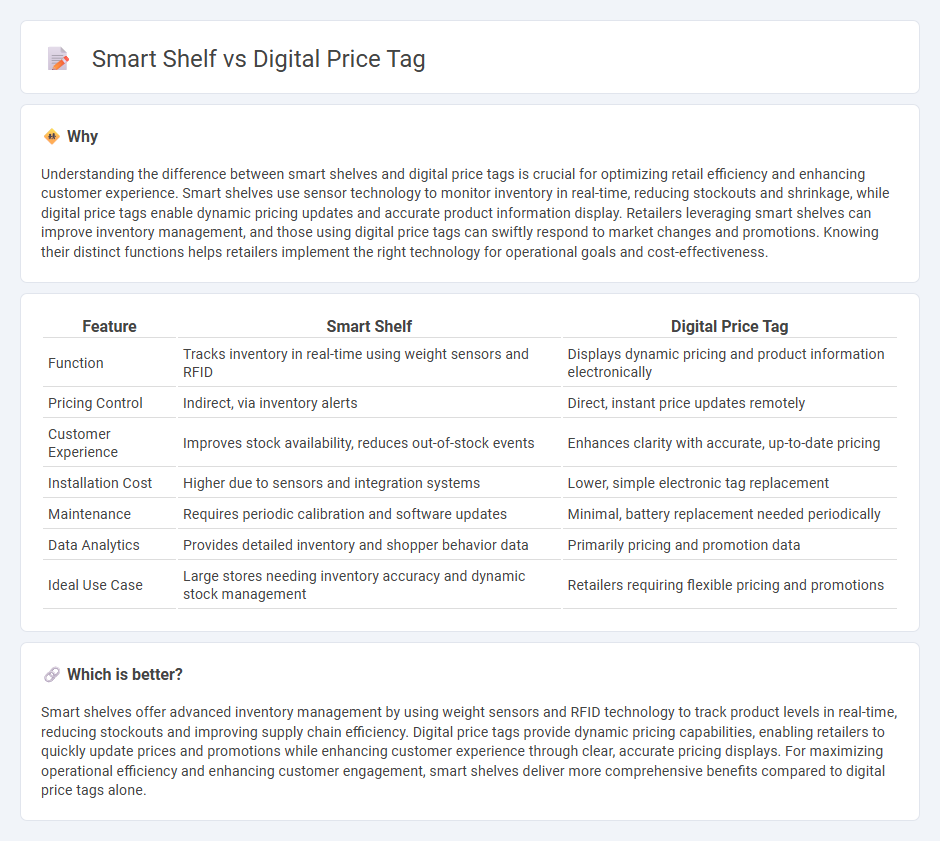
Smart shelves integrate sensors and real-time inventory tracking to optimize stock management and enhance customer experience, while digital price tags offer dynamic pricing updates and improved accuracy. Both technologies contribute to operational efficiency and increased sales by enabling retailers to respond swiftly to market demands. Explore how these innovations are transforming retail environments for greater profitability and convenience.
Why it is important
Understanding the difference between smart shelves and digital price tags is crucial for optimizing retail efficiency and enhancing customer experience. Smart shelves use sensor technology to monitor inventory in real-time, reducing stockouts and shrinkage, while digital price tags enable dynamic pricing updates and accurate product information display. Retailers leveraging smart shelves can improve inventory management, and those using digital price tags can swiftly respond to market changes and promotions. Knowing their distinct functions helps retailers implement the right technology for operational goals and cost-effectiveness.
Comparison Table
| Feature | Smart Shelf | Digital Price Tag |
|---|---|---|
| Function | Tracks inventory in real-time using weight sensors and RFID | Displays dynamic pricing and product information electronically |
| Pricing Control | Indirect, via inventory alerts | Direct, instant price updates remotely |
| Customer Experience | Improves stock availability, reduces out-of-stock events | Enhances clarity with accurate, up-to-date pricing |
| Installation Cost | Higher due to sensors and integration systems | Lower, simple electronic tag replacement |
| Maintenance | Requires periodic calibration and software updates | Minimal, battery replacement needed periodically |
| Data Analytics | Provides detailed inventory and shopper behavior data | Primarily pricing and promotion data |
| Ideal Use Case | Large stores needing inventory accuracy and dynamic stock management | Retailers requiring flexible pricing and promotions |
Which is better?
Smart shelves offer advanced inventory management by using weight sensors and RFID technology to track product levels in real-time, reducing stockouts and improving supply chain efficiency. Digital price tags provide dynamic pricing capabilities, enabling retailers to quickly update prices and promotions while enhancing customer experience through clear, accurate pricing displays. For maximizing operational efficiency and enhancing customer engagement, smart shelves deliver more comprehensive benefits compared to digital price tags alone.
Connection
Smart shelves use sensors and RFID technology to track inventory in real-time, while digital price tags update product prices dynamically based on demand, stock levels, and promotions. Integration of these technologies enables retailers to automate pricing strategies and optimize stock management, improving accuracy and customer experience. This connectivity reduces manual labor and enhances operational efficiency in retail environments.
Key Terms
Electronic Shelf Label (ESL)
Electronic Shelf Labels (ESL) offer dynamic pricing capabilities and real-time inventory updates, enhancing the efficiency of retail management compared to traditional digital price tags. ESLs integrate with smart shelf technology to provide data-driven insights, automate pricing adjustments, and improve customer experience by displaying accurate product information. Discover how combining ESLs with smart shelves transforms retail operations and boosts sales performance.
Real-time Inventory Management
Digital price tags provide dynamic pricing updates but offer limited real-time inventory visibility, whereas smart shelves use embedded sensors and RFID technology to track stock levels instantly, enabling precise inventory management. Smart shelves enhance operational efficiency by reducing stockouts and overstocks through continuous monitoring and automated alerts. Explore the advantages of integrating smart shelf technology for optimized inventory control.
Dynamic Pricing
Digital price tags enable real-time price adjustments directly on product displays, facilitating dynamic pricing strategies that respond instantly to market demand and competitor pricing. Smart shelves integrate sensors and data analytics to monitor inventory levels and customer interactions, feeding dynamic pricing algorithms with real-time insights to optimize pricing accuracy and maximize revenue. Explore how combining these technologies revolutionizes retail pricing and inventory management for dynamic market responsiveness.
Source and External Links
Digital price tags prompt concerns over price gouging - Digital price tags, such as those Walmart and Kroger are implementing, allow for quick price updates and labor savings but raise concerns over potential dynamic pricing and price gouging.
Electronic Shelf Labels / Digital Price Tags - Pricer - Pricer offers reliable, enterprise-grade electronic shelf labels that provide automatic price updates with cost efficiency and help enable in-store digital transformation.
Electronic Shelf Labels for Supermarkets & Retail - Alibaba.com - Electronic price tags automatically update prices from a central server, improve customer decision-making with product information, reduce labor, and optimize inventory management in retail stores.
 dowidth.com
dowidth.com